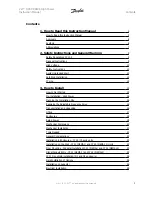
Operation Manual – ITW GSE 6400 Tier 4
Engine Controls
Trouble, Symptom,
Condition
Probable Cause
Test, Check, and/or Remedy
1.
The engine will not
start, and the
starter will not
crank the engine.
a. Emergency Stop
Make sure the
Emergency Stop
switch is pulled out
and switch has been pressed.
b. Battery Disconnect
switch is in the
OFF
position.
Make sure the battery disconnect switch is in the
ON
position.
c.
Battery discharged or
loose battery or ground
connection.
Make sure the voltage across the batteries is
approximately 13 VDC.
Check battery terminals.
Make sure 13 volts DC is reaching the starter solenoid
input terminal.
d.
Defective starter
solenoid (SW3).
Check if you can hear the starter solenoid activate
when the start button is pressed. If not, check for
voltage on the starter solenoid coil (see
e.
below).
Temporarily connect a large-capacity jumper cable
(No. 1/0 minimum) between the hot side of the starter
solenoid and the starter input terminal. If starter does
not crank engine, the starter may be defective
e.
No voltage at starter
solenoid coil.
Check connector X5 on the PC1 Interface board.
Verify that there is 12 VDC across the starter solenoid
+ and – terminals when the engine start pushbutton is
pressed.
Check and replace (if necessary) the Interface board.
f.
Defective starter.
Remove the starter motor from engine and apply
12 VDC to test it. Replace the starter if non-operable.
g.
Internal seizure.
If the starter is good, attempt to hand crank the engine
using a 3/4-inch square drive on the crankshaft pulley. If
engine cannot be turned one complete revolution,
internal seizure is indicated. Remove engine and
contact the engine manufacturer and/or nearest dealer.
i.
Defective Control Panel
Replace the Control Panel.
2.
Engine will not
start. Starter clicks
on and off.
a.
Low battery output
Check the battery and recharge or replace
b.
Loose starting circuit
connections or faulty
cables
Check all connections and cables. Tighten or replace as
required.
OM2248 Rev B
Page 88 of 104
















































